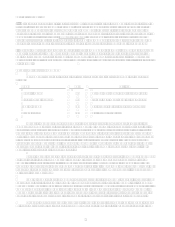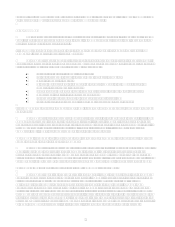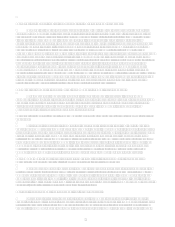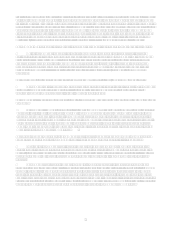Nutrisystem 2003 Annual Report Download - page 17
Download and view the complete annual report
Please find page 17 of the 2003 Nutrisystem annual report below. You can navigate through the pages in the report by either clicking on the pages listed below, or by using the keyword search tool below to find specific information within the annual report. 15
statement that became effective in December 2003.
As a result of a determination made in December 2000, the Company discontinued sales of the Sweet Success
product line in June 2001. Under then existing market conditions, the Company was unable to obtain the funding
required to rebuild the Sweet Success brand through consumer promotion. However, over the course of 2000 and 2001
the Company was able to generate $1,753 in net positive cash flow from the product line, consisting of $7,773 in
operating losses offset by $8,197 in non-cash expenses and a positive $1,329 in cash generated from reductions in
working capital. In 2000 and 2001, the Sweet Success product line provided a positive net cash flow of $1,212 and
$541, respectively, as cash generated through the operation of the product line and the disposal of inventory exceeded
payments related to the shut down of the product line.
The results of the Sweet Success product line have been reported separately as a discontinued operation in the
accompanying consolidated financial statements. Under the Companys ownership in 2000 and 2001, Sweet Success
generated sales of $4,215 and $3,350, respectively, and incurred an operating loss of $713 and an operating profit of
$813, respectively. In conjunction with the discontinuance of operation, in 2000 the Company recorded a loss on
disposition of $7,873, of which $7,650 related to the write down of intangible assets and the remaining $223 related to
various shut down costs. Except for a sale of intellectual property, Sweet Success was inactive in 2002. In December,
2002, the Company sold the intellectual property associated with Sweet Success for $150 cash, a $50 promissory note,
deferred payments based on sales achieved by the buyer and a warrant to purchase equity of the buyer. At this time,
management does not anticipate that the deferred payments or warrants will result in significant value to the Company.
The Company recorded a gain of $200 from the transaction.
Critical Accounting Policies and Estimates
The Companys consolidated financial statements are prepared in accordance with accounting principles
generally accepted in the United States. The Companys significant accounting policies are described in Note 2 to the
consolidated financial statements included in Item 8.
The preparation of these financial statements requires management to make estimates and assumptions that
affect the reported amounts of assets and liabilities, the disclosure of contingent assets and liabilities at the date of the
financial statements, and the reported amounts of revenues and expenses during the reporting period. Management
develops, and changes periodically, these estimates and assumptions based on historical experience and on various other
factors that are believed to be reasonable under the circumstances. Actual results may differ from these estimates under
different assumptions or conditions. Management considers the following accounting estimates to be the most critical in
preparing the consolidated financial statements. These critical accounting estimates have been discussed with the
Companys audit committee.
Reserves for Returns. Management reviews the reserves for customer returns at each reporting period and
adjusts them to reflect data available at that time. To estimate a return for reserves, management considers return rates in
preceding periods and changes in product offerings or marketing methods that might impact returns going forward. To
the extent the estimate of returns is inaccurate, management will adjust the reserve, which will impact the amount of
product sales revenue recognized in the period of the adjustment. Returns for 2001, 2002 and 2003 were $474, $1,482
and $1,174, respectively.
Impairment of Fixed Assets and Goodwill. Management continually assesses the impairment of long-lived
assets whenever events or changes in circumstances indicate that the carrying value of the assets may not be recoverable.
Judgments regarding the existence of impairment indicators are based on legal factors, market conditions and operating
performance of the Company. Future events could cause management to conclude that impairment indicators exist and
the carrying values of fixed assets may be impaired. Any resulting impairment loss would be limited to the value of net
fixed assets, which was $753 at December 31, 2003.
Income Taxes. NutriSystem experienced losses in 1999 and 2000. As a result, the Company has federal and
state tax net operating loss (NOL) carryforwards of approximately $8 million as of December 31, 2003. As a result of a
change of control transaction which occurred in December 2002, approximately $2 million of the NOLs are subject to
usage limitations pursuant to the rules of Internal Revenue Code section 382. Through March 2003, a valuation
allowance had been maintained for the deferred tax asset based on managements assessment that the deferred tax asset
would not be realized given the historical taxable levels of income (loss), the uncertainty of future operating results, tax
planning strategies, and the expiration date of net operating loss carryforwards. In the second quarter of 2003,
management determined that recognition of the benefits related to deferred tax assets was more likely than not based on
























